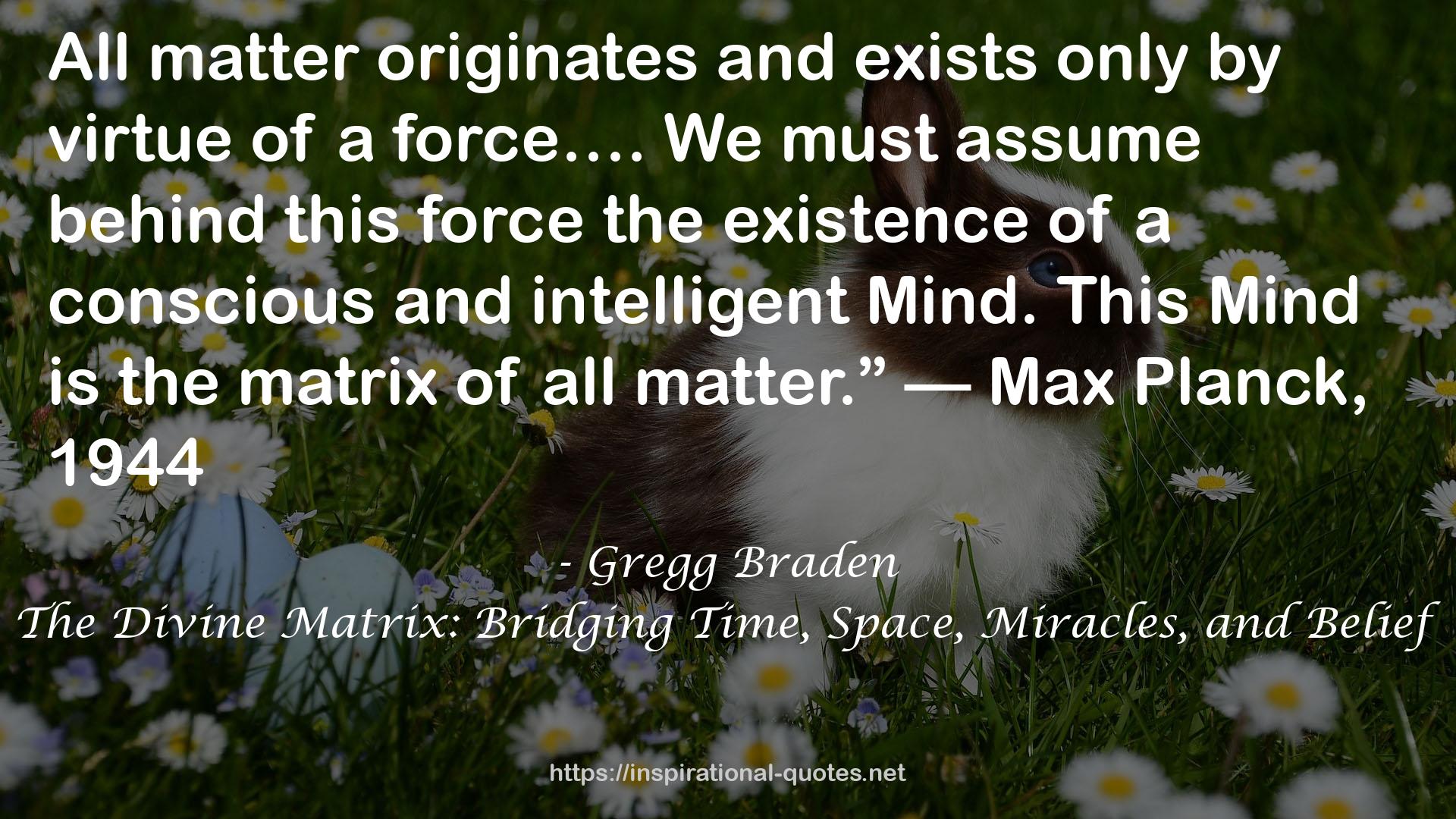55
" Modern science has discovered that through each emotion we experience in our bodies, we also undergo chemical changes of things such as pH and hormones that mirror our feelings.9 Through the “positive” experiences of love, compassion, and forgiveness and the “negative” emotions of hate, judgment, and jealousy, we each possess the power to affirm or deny our existence at each moment of every day. Additionally, the same emotion that gives us such power within our bodies extends this force into the quantum world beyond our bodies. It may be helpful to think of the Divine Matrix as a cosmic blanket that begins and ends in the realm of the unknown and spans everything between. This covering is many layers deep and is everywhere all the time, already in place. Our bodies, lives, and all that we know exist and take place within its fibers. From our watery creation in our mother’s womb to our marriages, divorces, friendships, and careers, all that we experience may be thought of as “wrinkles” in the blanket. From a quantum perspective, everything from the atoms of matter and a blade of grass to our bodies, the planet, and beyond may be thought of as a “disturbance” in the smooth fabric of this space-time blanket. Perhaps it’s no coincidence then that ancient spiritual and poetic traditions describe existence in much the same way. The Vedas, for example, speak of a unified field of “pure consciousness” that bathes and permeates all of creation.10 In these traditions, our experiences of thought, feeling, emotion, and belief—and all the judgment that they create—are viewed as disturbances, interruptions in a field that is otherwise smooth and motionless. "
― Gregg Braden , The Divine Matrix: Bridging Time, Space, Miracles, and Belief
58
" All matter originates and exists only by virtue of a force….
We must assume behind this force the existence
of a conscious and intelligent Mind.
This Mind is the matrix of all matter.” — Max Planck, 1944 With these words, Max Planck, the father of quantum
theory, described a universal field of energy that
connects everything in creation: the Divine Matrix. The Divine Matrix is our world.
It is also everything in our world.
It is us and all that we love, hate, create, and experience.
Living in the Divine Matrix, we are as artists expressing
our innermost passions, fears, dreams, and desires
through the essence of a mysterious quantum canvas.
But we are the canvas, as well as the images upon the canvas.
We are the paints, as well as the brushes. In the Divine Matrix, we are the container
within which all things exist, the bridge between
the creations of our inner and outer worlds,
and the mirror that shows us what we have created. "
― Gregg Braden , The Divine Matrix: Bridging Time, Space, Miracles, and Belief
59
" WE ARE THE ARTISTS AS WELL AS THE ART As far-fetched as this idea may sound to many people, it is precisely at the crux of some of the greatest controversies among some of the most brilliant minds in recent history. In a quote from his autobiographical notes, for example, Albert Einstein shared his belief that we’re essentially passive observers living in a universe already in place, one in which we seem to have little influence: “Out yonder there was this huge world,” he said, “which exists independently of us human beings and which stands before us like a great, eternal riddle, at least partially accessible to our inspection and thinking.”2 In contrast to Einstein’s perspective, which is still widely held by many scientists today, John Wheeler, a Princeton physicist and colleague of Einstein, offers a radically different view of our role in creation. In terms that are bold, clear, and graphic, Wheeler says, “We had this old idea, that there was a universe out there, [author’s emphasis] and here is man, the observer, safely protected from the universe by a six-inch slab of plate glass.” Referring to the late-20th-century experiments that show us how simply looking at something changes that something, Wheeler continues, “Now we learn from the quantum world that even to observe so minuscule an object as an electron we have to shatter that plate glass: we have to reach in there…. So the old word observer simply has to be crossed off the books, and we must put in the new word participator.”3 What a shift! In a radically different interpretation of our relationship to the world we live in, Wheeler states that it’s impossible for us to simply watch the universe happen around us. Experiments in quantum physics, in fact, do show that simply looking at something as tiny as an electron—just focusing our awareness upon what it’s doing for even an instant in time—changes its properties while we’re watching it. The experiments suggest that the very act of observation is an act of creation, and that consciousness is doing the creating. These findings seem to support Wheeler’s proposition that we can no longer consider ourselves merely onlookers who have no effect on the world that we’re observing. "
― Gregg Braden , The Divine Matrix: Bridging Time, Space, Miracles, and Belief

